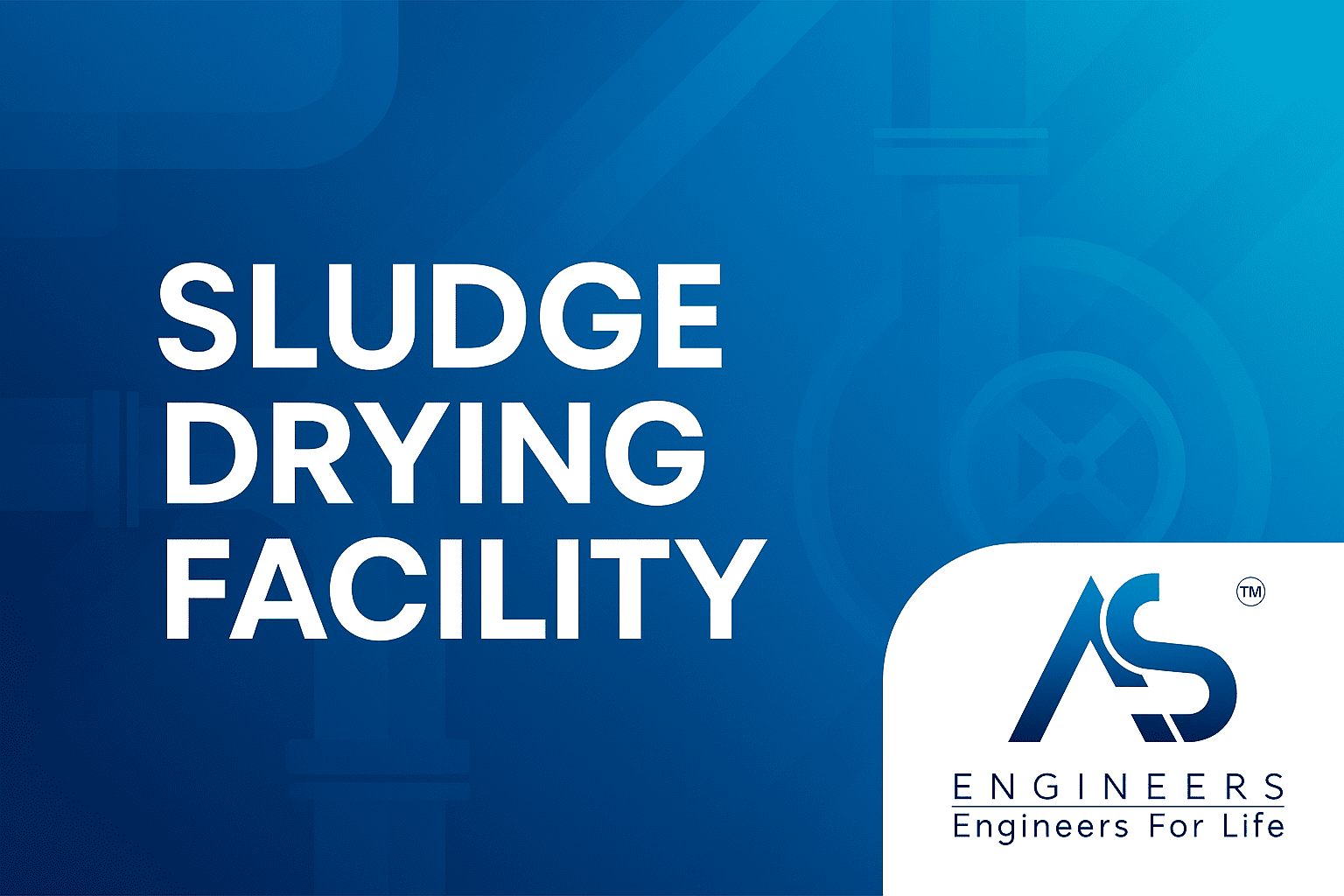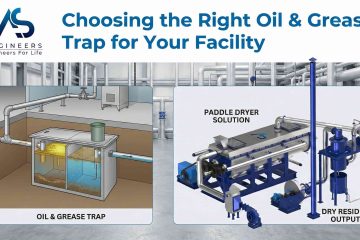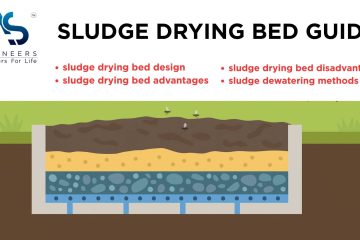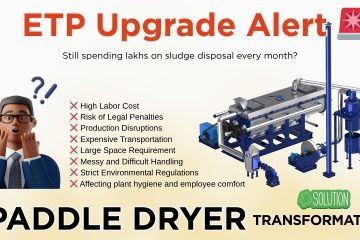Imagine standing in a large industrial plant, surrounded by pipes, tanks, and machinery, where one of the most persistent challenges is managing wet, heavy sludge. Every day, facilities across industries—from wastewater treatment plants to chemical factories—grapple with the same issue: how to reduce sludge volume efficiently, safely, and sustainably. This is where a sludge drying facility becomes indispensable.
A sludge drying facility is more than just equipment; it’s a complete system designed to minimize waste, cut down on disposal costs, and even transform sludge into a resource. In this guide, we’ll explore how sludge drying facilities work, why they are critical in modern waste management, and what to consider if you’re evaluating one for your operation.
By the end of this article, you’ll understand:
- How sludge drying facilities operate step by step.
- The real benefits—cost savings, efficiency, and environmental impact.
- Common misconceptions that hold industries back.
- Practical advice drawn from real-world projects and experiences.
Whether you’re a plant manager, an environmental officer, or simply curious about industrial waste management, this resource will give you actionable insights to make informed decisions about sludge drying.
How a Sludge Drying Facility Works (Step-by-Step)
Objective of this section:
- Clearly explain the process inside a sludge drying facility.
- Use the primary keyword naturally while describing.
- Keep it detailed yet digestible, using bullet points and examples for clarity.
- Position the explanation to help both technical and non-technical readers.
The Core Process of a Sludge Drying Facility
A sludge drying facility transforms wet sludge into a stable, dry material that is lighter, easier to handle, and often reusable. The process typically involves the following steps:
- Sludge Feeding and Pre-Treatment
- Sludge enters the facility directly from wastewater treatment plants or industrial processes.
- At this stage, screening and thickening often take place to remove large debris and reduce water content before drying.
- Pre-treatment ensures the system runs efficiently and protects the drying equipment from blockages.
- Thermal Drying
- The heart of the sludge drying facility is its thermal system.
- Using direct or indirect heating (via steam, hot air, or thermic fluid), the water inside the sludge is evaporated.
- The drying chamber—often a paddle dryer, belt dryer, or fluidized bed—ensures maximum heat transfer and controlled evaporation.
- Moisture Reduction and Odor Control
- As water vapor leaves the sludge, it passes through a condensation or scrubbing system to control odors and prevent harmful emissions.
- Modern facilities integrate air pollution control units, making the process environmentally compliant.
- Post-Drying Handling
- The dried sludge typically reduces in volume by up to 70–80%.
- Depending on the facility’s setup, the final product can be bagged, pelletized, or directly stored for further use.
- Common applications include using dried sludge as an alternative fuel, soil conditioner, or raw material in construction.
- Energy Recovery
- Many advanced sludge drying facilities recycle heat, making the process more energy-efficient.
- For instance, vapors generated during drying can be condensed and used for pre-heating incoming sludge.
Example: Paddle Dryer in a Sludge Drying Facility
One of the most widely used machines is the paddle dryer. It uses hollow shafts and paddles filled with hot fluid to indirectly heat and dry sludge. This design ensures:
- Uniform heat distribution.
- Compact footprint (saves space).
- Ability to handle sticky sludge that clogs other dryers.
At AS Engineers, for example, paddle dryers are often the centerpiece of sludge drying facilities, engineered to maximize efficiency while reducing operating costs.
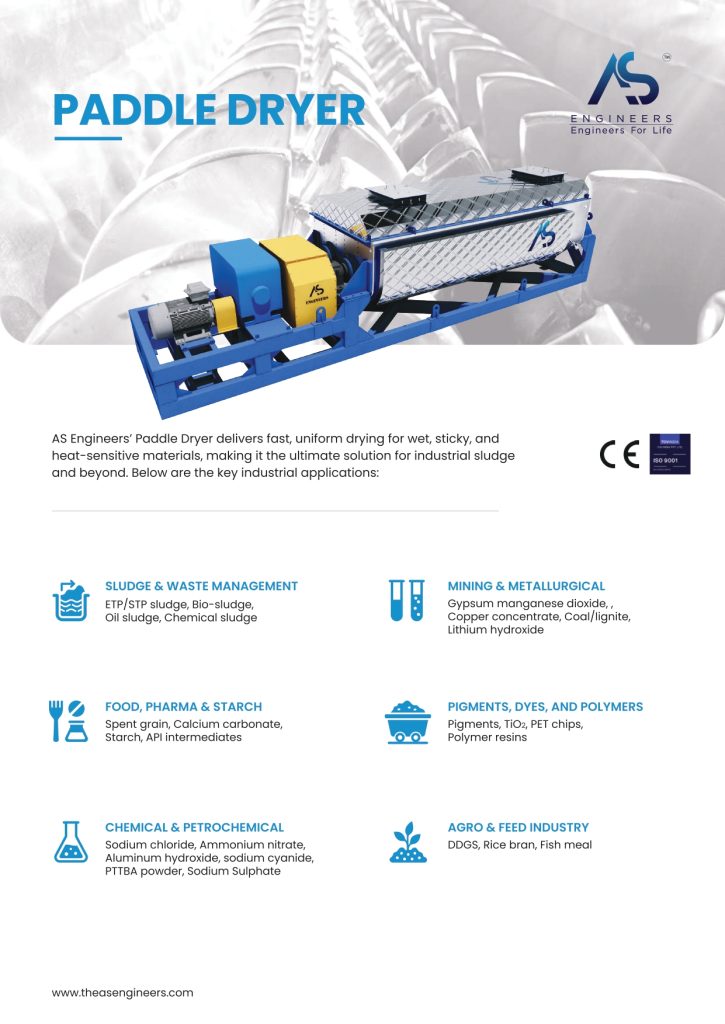
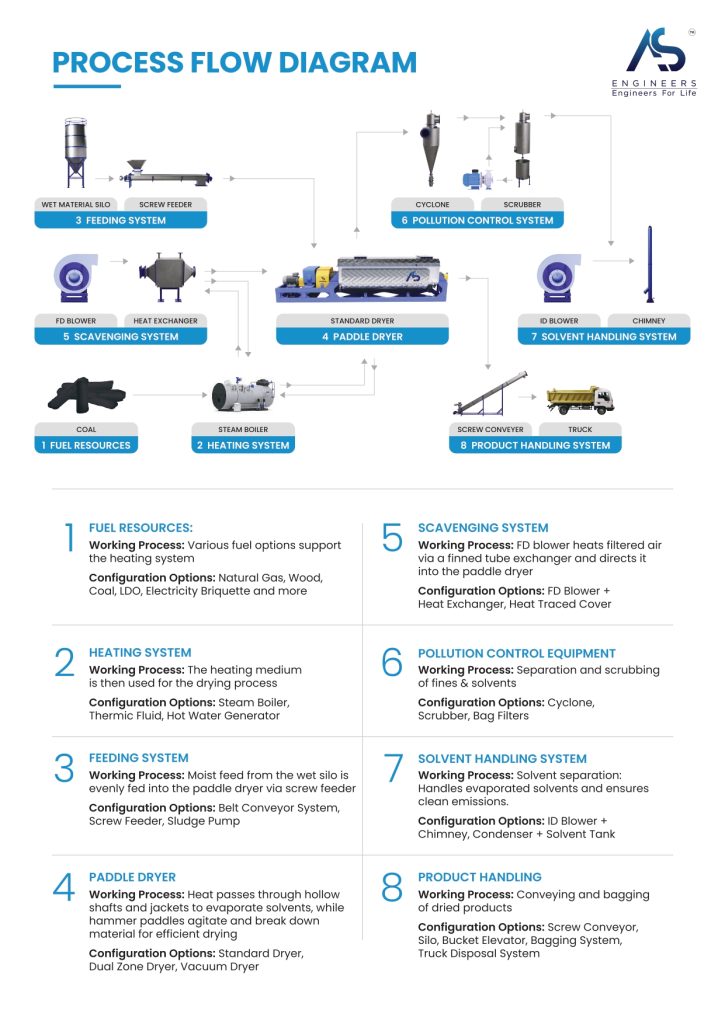
Benefits of a Sludge Drying Facility
Objective of this section:
- Show the value and advantages of investing in a sludge drying facility.
- Use data, examples, and practical outcomes to strengthen authority.
- Naturally integrate the primary keyword and LSI phrases like sludge treatment benefits, sludge disposal cost savings, sustainable sludge drying.
- Keep it relatable for decision-makers (plant managers, environmental officers, CEOs).
1. Significant Reduction in Sludge Volume and Weight
One of the biggest advantages of a sludge drying facility is its ability to drastically reduce sludge volume. Depending on the system, water content can drop from 80% moisture to less than 10%.
- This translates into up to 80% reduction in disposal costs, since fewer trucks and landfill spaces are required.
- In industries like paper, textile, and chemical plants, where sludge disposal is constant, this cost-saving adds up quickly.
2. Compliance with Environmental Regulations
Environmental agencies worldwide enforce strict regulations on sludge disposal. Facilities that fail to meet standards often face fines, shutdowns, or reputational damage.
A sludge drying facility ensures:
- Sludge is sanitized (pathogens destroyed at high temperatures).
- Reduced leachate risk when disposed of in landfills.
- Controlled emissions through integrated odor and vapor treatment systems.
This makes the process compliant and future-proof against tightening regulations.
3. Energy Efficiency and Resource Recovery
Modern sludge drying facilities are designed with energy recovery systems. For example:
- Heat exchangers recycle thermal energy.
- Vapors condensed from drying are used for pre-heating sludge.
- Dried sludge itself can be reused as a fuel substitute in cement kilns, boilers, or thermic fluid heaters.
Instead of being a liability, sludge becomes a valuable energy source—helping industries move closer to sustainability goals.
4. Flexibility Across Industries
Whether you operate a municipal wastewater treatment plant or a large-scale refinery, sludge characteristics vary. A sludge drying facility can be customized to handle:
- Oil sludge from refineries.
- Paper sludge from pulp and paper industries.
- ETP sludge from textile, food, and chemical plants.
- Biological sludge from municipal wastewater.
This versatility makes it a universal solution across industries.
5. Improved Safety and Hygiene
Handling wet sludge is not only costly but also unpleasant and risky for workers. It may contain pathogens, toxins, and foul odors.
By converting sludge into dry, stable granules or powder, a facility:
- Improves hygiene in plants.
- Reduces odor problems.
- Enhances worker safety by minimizing direct contact with hazardous waste.
6. Long-Term ROI (Return on Investment)
Although setting up a sludge drying facility requires initial investment, the long-term savings in transportation, landfill fees, and regulatory compliance often outweigh the cost.
- Payback periods can be as short as 2–4 years in high-sludge industries.
- The ability to repurpose dried sludge further increases profitability.
Real-World Insight
When I first visited a textile plant running a paddle dryer-based sludge drying facility, the plant manager shared that their monthly sludge disposal costs dropped by nearly 60%. The unexpected benefit? They began reusing part of the dried sludge as auxiliary fuel in their boilers—an option they hadn’t considered until engineers explained it. That moment made me realize how often industries overlook the hidden potential of sludge.
Common Misconceptions About Sludge Drying Facilities
Objective of this section:
- Address and debunk myths that discourage industries from adopting sludge drying facilities.
- Build authority by clarifying technical and financial misunderstandings.
- Naturally integrate the primary keyword while making the tone approachable.
Misconception 1: “Sludge drying facilities are too expensive to install.”
The Truth:
While the initial investment may appear high, the return on investment (ROI) is strong. Facilities often recover costs within a few years through savings on:
- Reduced sludge transportation and landfill fees.
- Lower regulatory fines due to compliance.
- Revenue streams from energy recovery and reuse of dried sludge.
When viewed long-term, a sludge drying facility is a cost-saving asset, not an expense.
Misconception 2: “They consume too much energy.”
The Truth:
Modern sludge drying facilities are highly energy-efficient. Many systems recycle thermal energy using:
- Condensate from vapor for pre-heating incoming sludge.
- Heat exchangers that reduce energy wastage.
- Options to power dryers with renewable energy or recovered fuels.
In some industries, dried sludge itself becomes a fuel substitute, offsetting a significant portion of energy costs.
Misconception 3: “Sludge drying is only for large industries.”
The Truth:
Facilities can be scaled to fit different needs. Smaller units serve:
- Municipal wastewater treatment plants in small towns.
- Medium-scale industries like textiles and food processing.
- Pilot plants or R&D centers that require controlled sludge treatment.
It’s not a one-size-fits-all model—customization makes sludge drying accessible across industries.
Misconception 4: “Dried sludge is still just waste.”
The Truth:
Dried sludge often becomes a resource. Depending on its composition, it can be:
- Used as a biofuel in kilns or boilers.
- Converted into soil conditioners for agriculture.
- Utilized in cement and construction materials.
This means a sludge drying facility transforms waste into a circular economy asset.
Misconception 5: “Odors and pollution will still be a problem.”
The Truth:
Advanced sludge drying facilities are equipped with air pollution control systems that:
- Neutralize odors with scrubbers or biofilters.
- Capture dust and vapor emissions.
- Ensure compliance with strict environmental norms.
In practice, these facilities often improve the overall air quality inside plants compared to traditional sludge storage.
Quick Takeaway
Most objections against sludge drying facilities come from outdated perceptions or limited exposure to modern technology. With today’s designs, these facilities are cost-efficient, eco-friendly, and scalable solutions that turn liabilities into resources.
Key Considerations Before Setting Up a Sludge Drying Facility
Objective of this section:
- Provide readers with a decision-making framework.
- Highlight practical, technical, and financial aspects.
- Naturally integrate the primary keyword while offering expert-backed guidance.
- Target plant managers, procurement officers, and decision-makers evaluating investments.
1. Sludge Characteristics
Not all sludge is the same, and its properties heavily influence facility design.
- Moisture content – High-water sludge requires more robust drying systems.
- Composition – Oil-based sludge behaves differently than biological sludge.
- Toxicity levels – Hazardous elements may require additional pollution control.
Facilities must be tailored to the type and quality of sludge being processed.
2. Scale and Capacity
The size of your operation determines the drying technology.
- Small facilities: Belt dryers or batch dryers are often cost-effective.
- Medium to large facilities: Paddle dryers, fluidized bed dryers, or rotary dryers provide better throughput.
- Future expansion: Plan for modular systems if sludge volume is expected to grow.
3. Energy Source and Efficiency
Since drying requires heat, energy planning is critical. Options include:
- Steam boilers (common in municipal plants).
- Thermic fluid heaters (preferred for consistent temperature control).
- Recovered heat or renewable energy (to cut costs and carbon footprint).
Choosing the right source ensures the sludge drying facility remains both cost-efficient and sustainable.
4. Environmental and Regulatory Compliance
Before setting up a facility, check:
- Local environmental regulations on emissions, noise, and disposal.
- Requirements for odor management and air pollution control units.
- Government incentives for sustainable waste management projects.
A compliant sludge drying facility avoids fines and operational delays while boosting corporate reputation.
5. Capital and Operating Costs
It’s important to evaluate:
- Initial investment – Land, equipment, and installation.
- Operating costs – Energy, labor, and maintenance.
- Savings & ROI – Lower disposal fees, reduced transport, and potential revenue from dried sludge.
Many companies underestimate operating savings and overestimate installation costs, leading to hesitation. A detailed cost-benefit analysis often reveals that sludge drying pays for itself in a few years.
6. Integration with Existing Systems
Your sludge drying facility should integrate smoothly with:
- Upstream processes (like dewatering equipment, filter presses, or centrifuges).
- Downstream systems (such as storage silos, bagging units, or combustion plants).
- Automation and monitoring tools to reduce labor costs and improve efficiency.
7. Vendor and Technology Selection
Choosing the right partner is just as important as the facility itself. Look for:
- Proven track record in sludge drying systems.
- Customization ability to suit your sludge type.
- After-sales service, spare parts availability, and training support.
For example, many industries prefer working with specialized manufacturers like AS Engineers, who design paddle dryer–based sludge drying facilities with robust support systems.
Real-World Applications of Sludge Drying Facilities Across Industries
Objective of this section:
- Demonstrate how sludge drying facilities serve multiple industries.
- Provide real-world use cases with industry-specific sludge types.
- Strengthen authority by showing versatility and practical impact.
- Naturally integrate the primary keyword while expanding context.
1. Municipal Wastewater Treatment Plants
- Challenge: Municipal plants generate vast amounts of biological sludge daily.
- Solution: A sludge drying facility reduces moisture, cutting transportation and landfill costs by more than half.
- Outcome: Many municipalities convert dried sludge into pellets for agricultural use, turning waste into a resource.
2. Pulp and Paper Industry
- Challenge: Paper mills produce fibrous sludge with high moisture content, often difficult to dispose of.
- Solution: Paddle dryer–based sludge drying facilities handle sticky paper sludge efficiently.
- Outcome: Dried sludge is reused as fuel in the mill’s boilers, creating a closed-loop energy cycle.
3. Textile Industry
- Challenge: Effluent treatment plants (ETPs) in textile units create colored, chemical-laden sludge.
- Solution: A customized sludge drying facility ensures safe disposal while minimizing odor.
- Outcome: Some plants use dried textile sludge as an auxiliary fuel, while others dispose of it in an environmentally safe manner.
4. Chemical and Pharmaceutical Plants
- Challenge: Hazardous sludge with solvents and chemicals needs specialized treatment.
- Solution: Facilities with indirect heating (like paddle dryers) reduce risks of explosions and emissions.
- Outcome: Companies not only achieve regulatory compliance but also reduce waste-handling costs.
5. Food Processing Industry
- Challenge: Sludge from dairy, beverage, and food plants contains organic matter prone to rapid decay.
- Solution: Drying stabilizes sludge, preventing odor and bacterial growth.
- Outcome: Dried food sludge can often be composted or used as animal feed supplements (depending on local laws).
6. Oil and Petrochemical Sector
- Challenge: Oil refineries and petrochemical units generate oily sludge, which is highly viscous and toxic.
- Solution: A sludge drying facility designed for oil sludge separates hydrocarbons and reduces moisture.
- Outcome: In many cases, dried sludge is reused as fuel in refinery furnaces, reducing waste and improving efficiency.
7. Cement and Construction Industry
- Challenge: Finding alternative fuels to cut costs and lower CO₂ emissions.
- Solution: A sludge drying facility produces dry granules suitable for co-incineration in cement kilns.
- Outcome: This reduces reliance on coal while promoting a circular economy approach.
Real Example:
When a mid-sized textile manufacturer in Gujarat, India, installed a paddle dryer–based sludge drying facility, they initially expected only to reduce landfill fees. Within six months, they discovered that the dried sludge could replace nearly 15% of their auxiliary boiler fuel. The investment not only solved their disposal issue but also cut their energy bill.
Future Trends and Innovations in Sludge Drying Facilities
Objective of this section:
- Highlight emerging technologies and practices shaping the future of sludge drying facilities.
- Reinforce thought leadership and E-E-A-T by showing forward-looking expertise.
- Naturally integrate the primary keyword while keeping the tone engaging and authoritative.
1. Integration with Renewable Energy
A growing trend is powering sludge drying facilities with renewable sources:
- Solar thermal systems can pre-heat sludge before mechanical drying.
- Biogas from anaerobic digestion of sludge can fuel the drying process.
- Some European plants already operate hybrid sludge drying facilities that combine solar and conventional dryers.
This not only lowers operating costs but also supports net-zero emission goals.
2. Smart Automation and IoT Monitoring
Digital transformation is making sludge drying facilities more efficient:
- Sensors monitor moisture content in real time.
- AI-driven systems adjust heat input for optimal drying.
- Predictive maintenance reduces downtime and increases equipment life.
Future facilities will likely run on semi-autonomous systems, reducing labor needs and human error.
3. Advanced Energy Recovery Systems
Next-generation sludge drying facilities focus heavily on energy circularity:
- Vapor condensation is reused for pre-heating or cleaning.
- Waste heat from other plant processes is redirected into dryers.
- Some designs integrate combined heat and power (CHP) units, turning waste heat into electricity.
These innovations mean tomorrow’s facilities could be nearly energy self-sufficient.
4. Modular and Mobile Drying Units
Industries are shifting towards modular sludge drying facilities that can be scaled or relocated as needed.
- Useful for temporary industrial setups.
- Ideal for municipalities that want to share resources across regions.
- Mobile units are gaining popularity in disaster-hit areas or remote sites where sludge disposal is urgent.
5. Circular Economy and By-Product Utilization
Instead of treating dried sludge as a by-product, future facilities will focus on resource recovery:
- Extracting phosphorus for use in fertilizers.
- Using ash from sludge incineration in cement and bricks.
- Converting organic dried sludge into biochar for soil enhancement.
This transforms the sludge drying facility into a resource hub rather than just a waste solution.
6. Stricter Global Regulations Driving Innovation
Governments across the world are tightening restrictions on sludge disposal.
- In the EU, landfilling untreated sludge is already banned.
- Countries like India and China are adopting stricter wastewater regulations.
- This regulatory push ensures sludge drying facilities will continue evolving with eco-friendly, compliant designs.
Expert Perspective
From my experience working with engineers and facility managers, I’ve noticed a clear shift: sludge drying facilities are no longer viewed as cost centers but as strategic sustainability investments. Companies that adopt them early gain a competitive edge—not only in compliance but also in energy and cost savings.
FAQs About Sludge Drying Facilities
Objective of this section:
- Provide short, authoritative answers to common queries.
- Increase chances of capturing featured snippets.
- Naturally integrate the primary keyword and related terms.
1. What is a sludge drying facility?
A sludge drying facility is a plant or system designed to reduce the moisture content in sludge, making it lighter, safer, and easier to handle. It uses thermal drying, mechanical processes, or both to convert wet sludge into a stable, dry form for disposal or reuse.
2. How does a sludge drying facility work?
A sludge drying facility works by:
- Receiving and pre-treating sludge (screening and thickening).
- Applying heat through dryers (paddle, belt, or fluidized bed).
- Removing vapor and controlling odors.
- Producing dried sludge that can be stored, disposed of, or reused as fuel or fertilizer.
3. Why are sludge drying facilities important?
They reduce sludge volume by up to 80%, lower disposal costs, improve hygiene, and ensure compliance with environmental regulations. Many facilities also recover energy and repurpose sludge, making them vital for sustainable waste management.
4. What types of dryers are used in sludge drying facilities?
Common dryers include:
- Paddle dryers (compact, efficient, handle sticky sludge).
- Belt dryers (good for large-scale, continuous drying).
- Fluidized bed dryers (high efficiency with uniform drying).
- Rotary dryers (traditional, versatile).
5. Can dried sludge be reused?
Yes. Depending on its composition, dried sludge can be:
- Used as an alternative fuel in kilns or boilers.
- Applied as a soil conditioner or fertilizer (if safe and compliant).
- Incorporated into cement, bricks, or construction materials.
6. What is the cost of setting up a sludge drying facility?
Costs vary based on scale, sludge type, and technology. While initial investment can be significant, most facilities achieve ROI in 2–4 years through reduced disposal costs, compliance benefits, and energy savings.
7. Is a sludge drying facility environmentally friendly?
Yes. Modern facilities include odor control, dust collection, and energy recovery systems. They not only minimize waste but also support circular economy practices by repurposing dried sludge.
Conclusion
Objective of this section:
- Summarize the blog clearly without redundancy.
- Reinforce the value of sludge drying facilities.
- End with an engaging CTA that encourages readers to take action.
- Naturally re-integrate the primary keyword in the closing lines.
Final Thoughts
Managing sludge has always been a challenge for industries and municipalities. But with the right approach, sludge doesn’t need to be a costly burden—it can become a resource. A sludge drying facility does more than shrink sludge volume; it ensures regulatory compliance, cuts transportation and disposal costs, enhances worker safety, and even generates new revenue streams through resource recovery.
As technology advances, sludge drying facilities are becoming smarter, greener, and more cost-efficient. Whether you’re in textiles, paper, municipal wastewater, or petrochemicals, the benefits remain the same: lower costs, better compliance, and improved sustainability.
If your organization is exploring solutions for sludge management, now is the time to act. Evaluate your sludge characteristics, explore scalable drying technologies, and choose a partner who brings proven expertise to the table.
At AS Engineers, we specialize in designing and manufacturing advanced sludge drying facilities—built to deliver efficiency, reliability, and long-term ROI. Ready to transform how you handle sludge? Contact us today to learn how our solutions can help your facility turn waste into opportunity.

